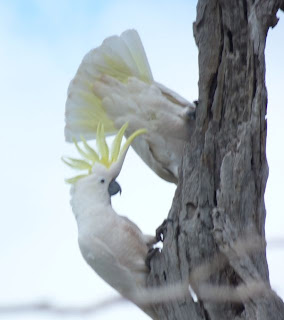ANPS follows COG on to McQuoids Hill
The COG Wednesday Walkers toured the base of McQuoids Hill some 5 weeks ago, but I did not blog this event. Today the ANPS group ascended the heights of the Hill (gaining about 90 vertical metres to 732m AMSL).
According to the ACT Place Names website "This feature is named after Thomas McQuoid, Sheriff of New South Wales, who was given the grant over "Tuggeranong" in 1837. (Ref: Frederick Robinson (1927), "Canberra's First Hundred Years and After".)"
It was a somewhat quiet day botanically (no orchids of any description!) but a few interesting things were seen. For a change I will start with birds.
These two cockatoos have set up a nest inside a spout on a large eucalypt. At one point they were both inside but then emerged to be chased by an Australian Raven, also with a nest in the area.
Somewhat later I came across this specimen of Cacatua galerita inconcinnus ....
... which soon returned to Mr Smooth.
Talking of smooth, this Nankeen Kestrel (1 of 2) was looking very silky.
Here is my entry for naff-photo of the year, but it does show a Striated Pardalote about to dive into its nest hollow. As well as providing a site for the family to be, the hollow also formed an echo chamber , causing the tiny bird's voice to boom around the bush.
Finally, you say, he gets to some plants. Clematis microphylla (or C. leptophylla - the taxonomists have been weaving their magic).
There was a lot of clematis around! Also Hardenbergia, but see below.
A valley full of Hardenbergia violacea.
Here is a close up of the fly on the Bulbine. I am pretty sure the yellow pattern on the wings is some transparent panels allowing the colour of the plant to show through!
There was a lot of rock around on the hill. Surprisingly none of it was augmented by reptiles. Perhaps they have been driven from the vicinity by the eruption of St John's Wort? These erect stones were interesting.
The view to the South ...
... and to the North,
Fortunately, even though we were quite close to Red Rocks Gorge, no members of the group were in this device. I was surprised, when looking at the image en ordinateur, how close he was to the tree ( and the ground)
The amount of weed around was a worry. I suspect the ACT will again go yellow when the St John's Wort hits its straps later in the year. In addition to all the other bad stuff, we noted a prickly pear (Opuntia sp.) which was dug up with a stick and left to dry.
According to the ACT Place Names website "This feature is named after Thomas McQuoid, Sheriff of New South Wales, who was given the grant over "Tuggeranong" in 1837. (Ref: Frederick Robinson (1927), "Canberra's First Hundred Years and After".)"
It was a somewhat quiet day botanically (no orchids of any description!) but a few interesting things were seen. For a change I will start with birds.
These two cockatoos have set up a nest inside a spout on a large eucalypt. At one point they were both inside but then emerged to be chased by an Australian Raven, also with a nest in the area.
Somewhat later I came across this specimen of Cacatua galerita inconcinnus ....
... which soon returned to Mr Smooth.
Talking of smooth, this Nankeen Kestrel (1 of 2) was looking very silky.
Here is my entry for naff-photo of the year, but it does show a Striated Pardalote about to dive into its nest hollow. As well as providing a site for the family to be, the hollow also formed an echo chamber , causing the tiny bird's voice to boom around the bush.
Finally, you say, he gets to some plants. Clematis microphylla (or C. leptophylla - the taxonomists have been weaving their magic).
There was a lot of clematis around! Also Hardenbergia, but see below.
Acacia melanoxylon
Acacia rubida
(with some Hardenbergia - see below - in the background.
After some debate it was considered this next plant was Styphelia triflora. Note the red seeds: the other contender was Melichrus but that was all in peak flowering form.A valley full of Hardenbergia violacea.
Stackhousia monogyna
Vittadinnia cuneata
Bulbine bulbosa plus fly.
Pomaderris pallida (possibly the most profuse endangered plant in the ACT)Here is a close up of the fly on the Bulbine. I am pretty sure the yellow pattern on the wings is some transparent panels allowing the colour of the plant to show through!
There was a lot of rock around on the hill. Surprisingly none of it was augmented by reptiles. Perhaps they have been driven from the vicinity by the eruption of St John's Wort? These erect stones were interesting.
The view to the South ...
... and to the North,
Fortunately, even though we were quite close to Red Rocks Gorge, no members of the group were in this device. I was surprised, when looking at the image en ordinateur, how close he was to the tree ( and the ground)
The amount of weed around was a worry. I suspect the ACT will again go yellow when the St John's Wort hits its straps later in the year. In addition to all the other bad stuff, we noted a prickly pear (Opuntia sp.) which was dug up with a stick and left to dry.























Comments